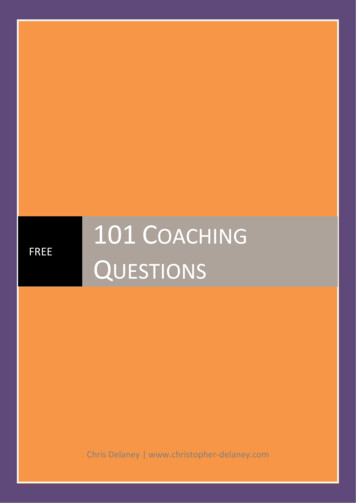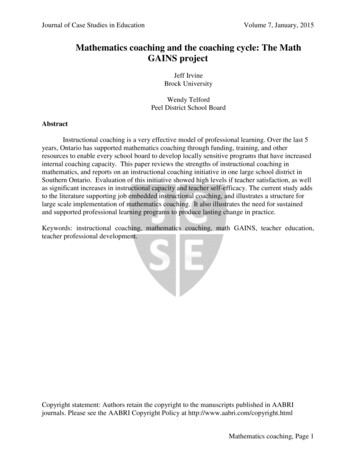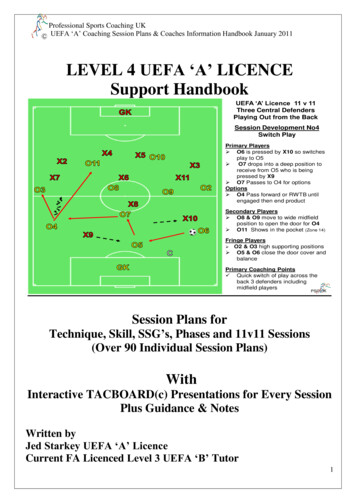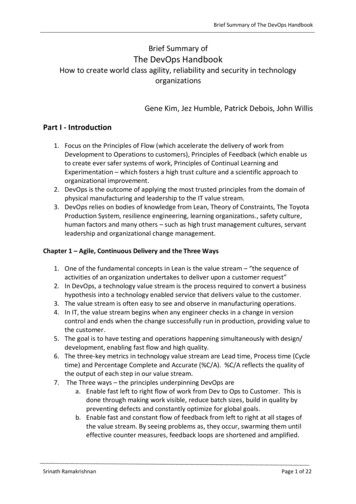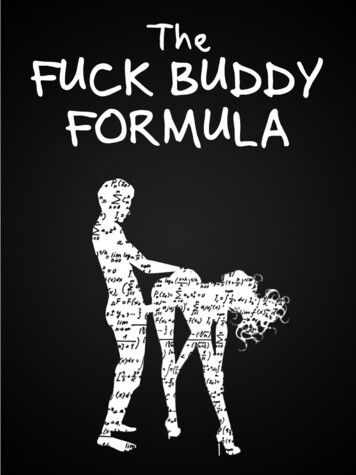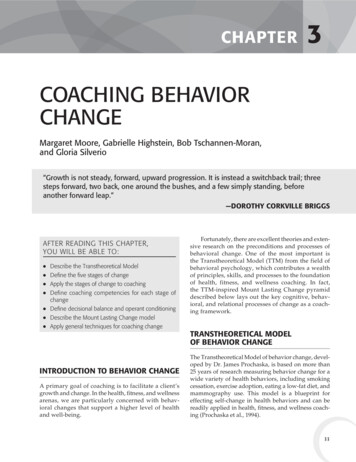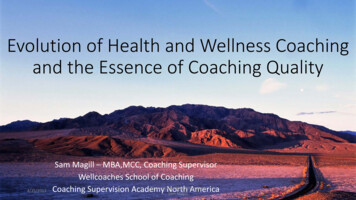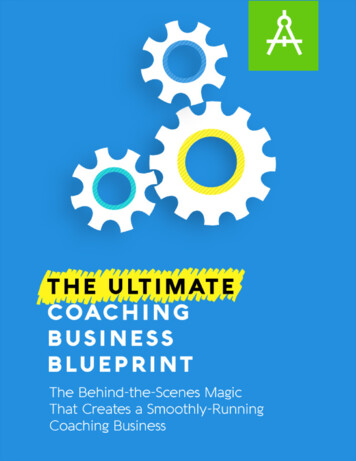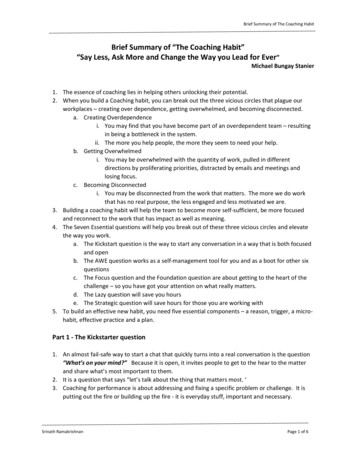
Transcription
Brief Summary of The Coaching HabitBrief Summary of “The Coaching Habit”“Say Less, Ask More and Change the Way you Lead for Ever”Michael Bungay Stanier1. The essence of coaching lies in helping others unlocking their potential.2. When you build a Coaching habit, you can break out the three vicious circles that plague ourworkplaces – creating over dependence, getting overwhelmed, and becoming disconnected.a. Creating Overdependencei. You may find that you have become part of an overdependent team – resultingin being a bottleneck in the system.ii. The more you help people, the more they seem to need your help.b. Getting Overwhelmedi. You may be overwhelmed with the quantity of work, pulled in differentdirections by proliferating priorities, distracted by emails and meetings andlosing focus.c. Becoming Disconnectedi. You may be disconnected from the work that matters. The more we do workthat has no real purpose, the less engaged and less motivated we are.3. Building a coaching habit will help the team to become more self-sufficient, be more focusedand reconnect to the work that has impact as well as meaning.4. The Seven Essential questions will help you break out of these three vicious circles and elevatethe way you work.a. The Kickstart question is the way to start any conversation in a way that is both focusedand openb. The AWE question works as a self-management tool for you and as a boot for other sixquestionsc. The Focus question and the Foundation question are about getting to the heart of thechallenge – so you have got your attention on what really matters.d. The Lazy question will save you hourse. The Strategic question will save hours for those you are working with5. To build an effective new habit, you need five essential components – a reason, trigger, a microhabit, effective practice and a plan.Part 1 - The Kickstarter question1. An almost fail-safe way to start a chat that quickly turns into a real conversation is the question“What’s on your mind?” Because it is open, it invites people to get to the hear to the matterand share what’s most important to them.2. It is a question that says “let’s talk about the thing that matters most. ‘3. Coaching for performance is about addressing and fixing a specific problem or challenge. It isputting out the fire or building up the fire - it is everyday stuff, important and necessary.Srinath RamakrishnanPage 1 of 6
Brief Summary of The Coaching Habit4. Coaching for development is about turning the focus from the issue to the person dealing withthe issue, the person who is managing the fire. This conversation is rare and is significantlymore powerful.5. The 3P model is a framework for choosing what to focus on in a coaching conversation – fordeciding which aspect of a challenge might be at the heart of a difficulty that the person isworking through.6. The 3Ps refer to Projects, People and Patterns.a. The Project side refers to challenges around the actual content.i. What projects do you need to abandon or postpone?ii. What meetings will you no longer attend?iii. What resources do you need to divert to the Yes?b. The People side refers to issues with team members, colleagues, customers or clientsi. What expectations do you need to manage?ii. What relationships will you let wither?c. The Patterns refers to if there is a way that you are getting in your own way and notshowing up in the best possible way, where should we start.i. What habits do you need to break?ii. What old stories or dated ambitions do you need to update?iii. What beliefs about yourself do you need to7. Asking the Kickstart question works as a little pressure release valve and helps make explicitsomething that might be unduly influencing the way you work.Part 2 – The AWE question1. “And what else” – a seemingly innocuous question – creates more wisdom, more insights, moreself-awareness and more possibilities out of thin air. It is the quickest and easiest way touncover and create new possibilities.2. Asking “What else” – will you to more options and often better options. Better options lead tobetter decisions and better decisions lead to better success.3. It is the simplest way to stay lazy and stay curious. You could ask this question at least threetimes – till the coachee says “there is nothing else” - then you can move on to the next question.If you have got 3-5 answers to the question – “What else” – you have made good progress.Part 3 – The Focus question1. The focus question – “what is the real challenge here for you?” – this is the question thatwill help slow down the rush to action, so you spend time solving the real problem and notthe first problem.2. Three sets of questions bring out different perspectives:a. What’s the challenge? Curiosity is taking you in the right direction, but phrased likethis the question is too vague. It would most likely generate either an obviousanswer or a somewhat abstract answer – neither of which is helpful.b. What’s the real challenge here? implied here is that there are a number ofchallenges to choose from – you would have to find one that matters the most.Phrased like that, will make them slow down and think more deeply.Srinath RamakrishnanPage 2 of 6
Brief Summary of The Coaching Habitc. What’s the real challenge here for you? – Pins the question to the person you aretalking to. It keeps the question personal and makes the person you are talking towrestle with her struggle and what she needs to figure out.3. If the person talks of many challenges – asking the question “if you had to pick up one ofthese to focus on, which one would be the real challenge for you?” would do the trick.Stick to questions starting with “What”1. In a focused conversation with the people you are managing, it is better not to ask “Why”a. One – you put them on the defensive. Get the tone wrong – the why could come acrossas “What the hell were you thinking?”b. Two – you are trying to solve the problem. You ask why because you want more detailand you want more detail because you want to fix the problem.2. If you are trying to fix things – you don’t need the backstory. Stick to questions starting with“What” and avoid questions starting with “Why”3. It is better to reframe the questions starting with “why” to starting with “what”. E.g. why didyou do that? Can be reframed as What were you hoping for there? Or What made you chosethis course of action? What’s important for you here?Part 4 – The Foundation Question1. Asking the question “What do you want?” – could be a very difficult question to answer. Weoften don’t know what we “actually” want. Even if that question is answered, “What do youreally want” would typically stop them in their tracks.2. Even if you know what you want and are courageous enough to ask for what you want, it isoften hard to say it in a way that is clearly heard and understood.3. According to GB Shaw “the single biggest problem with communication is the illusion that it hastaken place”4. A distinction should be drawn around wants and needs – Want – I’d like to have this. Need – Imust have this.5. In Marshall Rosenberg’s model of NVC, wants are surface requests, the tactical outcomes we’dlike from a situation. Needs go deeper and identifying them helps you pull back the curtain tounderstand the more human driver who might be behind the want.6. There are nine self-explanatory universal needs – Affection, Creation, Recreation, Freedom,Identity, Understanding, Participation, Protection and Subsistence.7. When you ask someone “What do you want?” - listen to see the need that likely lies behind theperson’s request. For example, when some one saysa. “I want you to talk to the VP for me” - it is about protection.b. “I want to leave early today” – it is about understandingc. “I want you do a new version of the report” - may be about freedom or identity.8. The fundamental organization principle of the brain as per Evan Gordon is the risk and rewardresponse. Five times a second, at an unconscious level, your brain is scanning the environmentaround you and asking itself, “Is it safe here? Or is it dangerous?”9. There are four primary drivers that influence how the brain reads any situation. Your job is toincrease the TERA quotient whenever you can. TERA stands forSrinath RamakrishnanPage 3 of 6
Brief Summary of The Coaching Habita. T – Tribe – The brain is asking “Are you with me or are you against me”. If you are on itsside, your TERA quotient goes up.b. E – Expectation – This is about “Do I know the future or don’t I? If what is going tohappen next is clear, the situation feels safe.c. R – Rank - Are you more important or less important than I am? It is about how aformal title or on how power is being played out at the moment.d. A – Autonomy – based on Dan Pink’s Drive. “Do I get a say or don’t I”. That is thequestion the brain is asking as it gauges the degree of autonomy you have in anysituation.10. Therapists talk of a miracle question – “Suppose that tonight while you are sleeping a miraclehappens. When you get up in the morning tomorrow, how will you know that things havesuddenly got better?”11. The miracle question helps people to courageously image what better really looks like.12. The Foundation question “What do you want” is direct and has the same effect of pulling peopleto the outcome and once you see the destination, the journey becomes clearer.Part 5 – The Lazy question1. Silence is often a measure of success. It may be that the person you are coaching is the typewho needs a moment or two to formulate the answer in his head before speaking it. This isabout giving that space.2. Edgar Schein in his book “Helping” talks of an insight when you offer to help someone, you “oneup” yourself, you raise your status and you lower theirs, whether you mean it or not.3. Stephen Karpman has come out with a Drama Triangle (quite like the TA model) – where he sayswe are dancing between three archetypal roles – the Victim, Persecutor and Rescuer – each ofwhich are unhelpful and dysfunctional as the other.a. Victimi. Core Belief – “My life is hard, my life is unfair”, “Poor me”ii. The Dynamic – “it is not my fault” (it is theirs)iii. Benefits of playing the role – You have no responsibility for fixing anything, youget to complain, you attract Rescuersiv. Price paid : You have no sense of being able to change anythingb. Persecutori. Core Belief – “I am surrounded by fools, idiots, or just people less good thanme”ii. The Dynamic – “it is not my fault” (it is yours)iii. Benefits of playing the role – You feel superior and have a sense of power andcontroliv. Price paid - You end up being responsible for everything.c. Rescueri. Core Belief – “Don’t fight, don’t worry, let me jump in and take it on and fix it”ii. The Dynamic – “It is my fault” (not yours)iii. Benefits of playing the role – You feel morally superior, you believe you areindispensableSrinath RamakrishnanPage 4 of 6
Brief Summary of The Coaching Habitiv. Price paid : People reject your help. You create victims and perpetuate theDrama Triangle.4. These three labels are not descriptions of who you are – they are descriptions of how you arebehaving in a given situation. No one is inherently a Victim / Persecutor / Rescuer. These areroles we end up playing when we have been triggered and in that state, find a less than effectiveversion of ourselves playing out.5. The question “How can I help?” forces your colleague to make a direct and clear request.Also itstops you from thinking that you know how best to help and leaping into action. Or being moreblunt – you could ask – “What do you want from me?”6. A way to soften this question is to use phrases like, “Out of curiosity”, “just so I know”, “To helpme understand better”, “To make sure I am clear”Part 6 – The Strategic question1. “If you are saying Yes to this, what are you saying No to” is a strategic question askingpeople to be clear and committed to their Yes. Too often we halfheartedly agree onsomething or more likely there is a clear misunderstanding in the room as to what has beenagreed upon.2. A Yes is a nothing without the No that gives it boundaries and form.3. What exactly are you saying Yes to – brings the commitment out of the shadows. Andasking, “What could be being fully committed to the idea look like” – brings things intosharper focus.4. Saying Yes more slowly means being willing to stay curious before committing. Whichmeans asking more questionsa. Why are you asking me?b. Whom else have you asked?c. When you say this is urgent, what do you mean?d. If I couldn’t do all of this, but could do just a part, what part would you have me todo?e. What do you want me to take off my plate so that I can do this?Part 7 – The Learning question1. People don’t really learn when you tell them something – they don’t really learn when they dosomething. They start learning, start creating neural pathways only when they have a chance torecall and reflect on what just happened.2. Chris Argyris coined the term “double loop learning” – in the first loop, you are trying to fix aproblem and the second loop is about creating a learning moment about the issue at hand. It isin the second loop where people pull back and find the insight.3. A question that drives the double loop learning is “What was most useful for you”?4. Adding “for you” to the question takes it from the abstract to the personal, from the objectiveto the subjective. Also it will give you guidance on what to do more of next time and it willreassure you that you are being useful even when you are not giving advice but are askingquestions instead.Srinath RamakrishnanPage 5 of 6
Brief Summary of The Coaching Habit5. When we take time and effort to generate knowledge and find an answer rather than justreading it, our memory retention is increased. If we as coaches ask you a question and yougenerate an answer yourself, the odds of your retention / doing it greatly increases.6. The first major tactic they share is harnessing the impact of information retrieval. “What isessential is to interrupt the process of forgetting”7. Questions such as “What did you learn”, What was the key insight” What was important tocapture” is to drive the retrieval process and embed the learning.8. These Seven Essential questions are part of your management repertoire and everydayconversations, you will work less hard, you will have more impact and boost your career.9. The real secret sauce is to build a habit of curiosity – finding your own questions, find your ownvoice and build your own coaching habit.*******************************Srinath RamakrishnanPage 6 of 6
Brief Summary of “The Coaching Habit” “Say Less, Ask More and Change the Way you Lead for Ever” Michael Bungay Stanier 1. The essence of coaching lies in helping others unlocking their potential. 2. When you build a Coaching habit, yo
